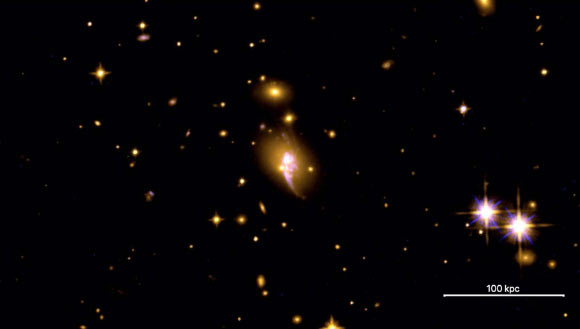As part of the Clusters Hiding in Plain Sight (CHiPS) survey, astronomers have discovered three new galaxy cluster candidates and confirmed two of them: CHIPS 1356-3421 and CHIPS 1911+4455.

This Hubble image shows the galaxy cluster CHIPS1911+4455. Image credit: NASA / ESA / Hubble Heritage Team.
In 2012, MIT astronomer Michael McDonald and colleagues discovered SPT-CLJ2344-4243, a galaxy cluster unlike any other.
The cluster’s central galaxy hosts a supermassive black hole that is in the process of devouring star-forming gas, which fuels a pair of powerful jets that erupt from the black hole in opposite directions into intergalactic space.
In its core, SPT-CLJ2344-4243 — which is also known as the Phoenix cluster — forms stars at a rate roughly 500 times higher than most other clusters, giving it the blue glow of a young star population instead of the typical red hue of aging stars.
“We’d been looking for a system like this for decades,” Dr. McDonald said.
“And yet, it had been observed and passed over years prior, assumed to be a single galaxy instead of a cluster.”
“It’d been in the archive for decades and no one saw it. They were looking past it because it didn’t look right.”
“And so, what other unusual clusters might be lurking in the archive, waiting to be found? Thus, the CHiPS survey was born.”
Dr. McDonald’s team identified 11 cluster candidates around X-ray, radio, and mid-IR-bright sources, including six well-known clusters, two false associations of foreground and background clusters, and three new candidates: CHIPS 1356-3421, CHIPS 1911+4455 and CHIPS2155-3727.
With additional follow-up data from NASA’s Chandra X-ray telescope, they confirmed two candidates: CHIPS 1356-3421 and CHIPS 1911+4455.
CHIPS 1911+4455 is similar in many ways to the rapidly-star-forming Phoenix cluster, but with a highly disturbed X-ray morphology on large scales.
“This cluster invites further study, however, as it has a twisted shape with two extended arms, whereas all other rapidly-cooling clusters are circular,” the astronomers said.
“We believe it may have collided with a smaller galaxy cluster.”
“It’s super unique compared to all the galaxy clusters that we now know,” said Taweewat Somboonpanyakul, a Ph.D. student at the Kavli Institute for Astrophysics and Space Research at MIT.
In all, the CHiPS survey revealed that older X-ray surveys missed roughly 1% of galactic neighborhoods because they look different than the typical cluster.
This can have significant implications, since astronomers study galaxy clusters to learn about how the Universe expands and evolves.
“We need to find all the clusters to get those things right,” Dr. McDonald said.
“99% completion isn’t enough if you want to push the frontier.”
A paper on the findings was published in the Astrophysical Journal.
_____
Taweewat Somboonpanyakul et al. 2021. The Clusters Hiding in Plain Sight (CHiPS) Survey: Complete Sample of Extreme BCG Clusters. ApJ 910, 60; doi: 10.3847/1538-4357/abe1bc







